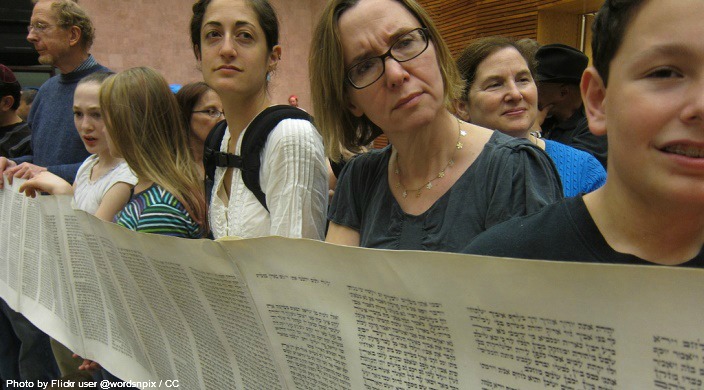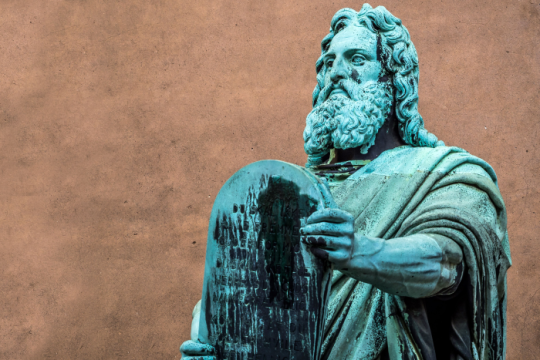
Immediately after the High Holidays, we celebrate Sukkot, one of the most important biblical Jewish holidays. How do we commemorate the Israelites' journey from bondage in Egypt to the Promised Land? We build a sukkah, a temporary hut constructed of wood and canvas, and dwell within it for seven days. We gather with friends and family under the canopy to socialize, eat, and recite special prayers over the etrog and the lulav, waving the collected branches - four different species noted in the Torah - in all directions.
Simchat Torah (Rejoicing in Torah), which follows Sukkot, is my favorite Jewish holiday, not only because it's my birthday, but also because of its profound meaning. Simchat Torah celebrates the conclusion of the annual cycle of public Torah readings - when we finish the Book of Deuteronomy and begin all over again with the Book of Genesis.
As a perceptive - yet presumptuous kid - I asked my granddad: "Why do we have to read it again, when we have already read it?" With a half a grin he replied: "Well, Gilad, don't you celebrate your birthday every year?" Although I understand it now, at that time I had yet to comprehend this apt analogy: Indeed, just as we celebrate our birthdays as a way to acknowledge where we came from, so, too, do we celebrate Simchat Torah to remind ourselves of our people's story, and, in so doing, help to ensure our future.
So how do we celebrate Simchat Torah? Not by reciting any grand blessings nor by waving the four species in the lulav. Not with exuberant gestures nor by performing any particular mitzvot. No, instead we recognize, honor, and celebrate the gift of Torah, which depending on one's belief, may be analogous to our relationship with God. Acknowledging the gift of Torah helps us to understand the might of the Jewish people, as well as our perseverance, resistance, and ability to thrive, keeping alive our ancestors' legacy and traditions.
Whether you are in an Orthodox shul or a Reform synagogue on erev Simchat Torah, you will witness a joyous celebration in which the Torah scrolls are removed from the ark and carried around the sanctuary seven times. Known as the "seven hakafot," this ritual - followed by singing and dancing by all - is one way to honor and celebrate the Torah, as well as to demonstrate that it belongs to every Jew.
Why, you might ask, do we rejoice in the Torah on Simchat Torah and not Shavuot, when we celebrate receiving the Torah from God? Can't we just combine the two holidays into one? To answer this question, I will conclude with the parable of the Maggid of Dubno, as retold by Rabbi Chanan Morrison.
Once there was a king and queen who were childless for many years. In desperation, they visited a wise, old man who gave them a powerful blessing, but with one condition. If a daughter were to be born to them, no man must see her until her wedding day, lest she die! When the queen gave birth to a baby girl, a secluded island was prepared on which the princess would live.
After many years, the princess came of age. The king approached a nobleman whom he respected and suggested that he marry his daughter.
"Certainly!" was the enthusiastic response.
"When can I meet her?"
The king then explained that his daughter could not be seen before her wedding day. Surprised by this answer, the nobleman declined the match. Perhaps the princess was unpleasant or ugly, or perhaps she was scarred with some terrible defect. None trusted the king's promise that she was beautiful and kind.
Finally, the last man the king approached told the king that he was greatly honored by the offer. If the princess had the character of her royal parents, then he would be delighted to marry her - even without seeing her before the wedding day.
A date was set and the whole world was invited to the celebration. A marvelous time was had by all... except the groom! He was overcome with anxiety. He had, until then, hidden his fears over not having met his future bride. But during the wedding, the tension showed. Even after the wedding, the groom remained apprehensive. He feared that, although she was beautiful, perhaps an inner ugliness would surface.
The groom's fears, however, were groundless. The princess was a true gem, a beautiful person inside and out. Over time, he came to appreciate more and more deeply his wife's beauty, charm, and wisdom. Each day, another wondrous facet of the princess was revealed.
Rabbi Jacob ben Wolf Kranz explained that when the Torah was offered to the world, the nations had many questions about its contents. The Jewish people, however, were committed to keeping it, even before understanding everything it contained.
Yet their promise of total trust was incomplete. The mind can know and decide what the heart is not ready to accept. Only after living with Torah - completing a full cycle of reading it and experiencing its teachings that the Jewish people were ready - on Simchat Torah - to express their (and our) great joy over God's precious gift.
Gilad Atlacevitz was born in Haifa and attended the Leo Baeck High School . Gilad is a Lech L'cha Fellow for Greene Family Camp and Congregation Beth-El in Fort Worth, TX.


